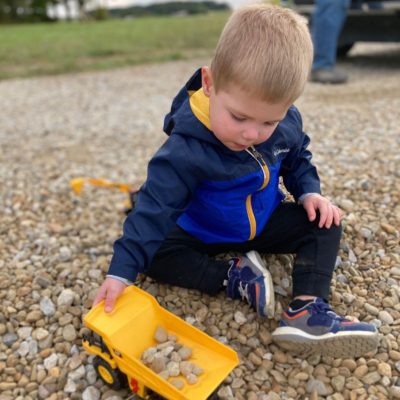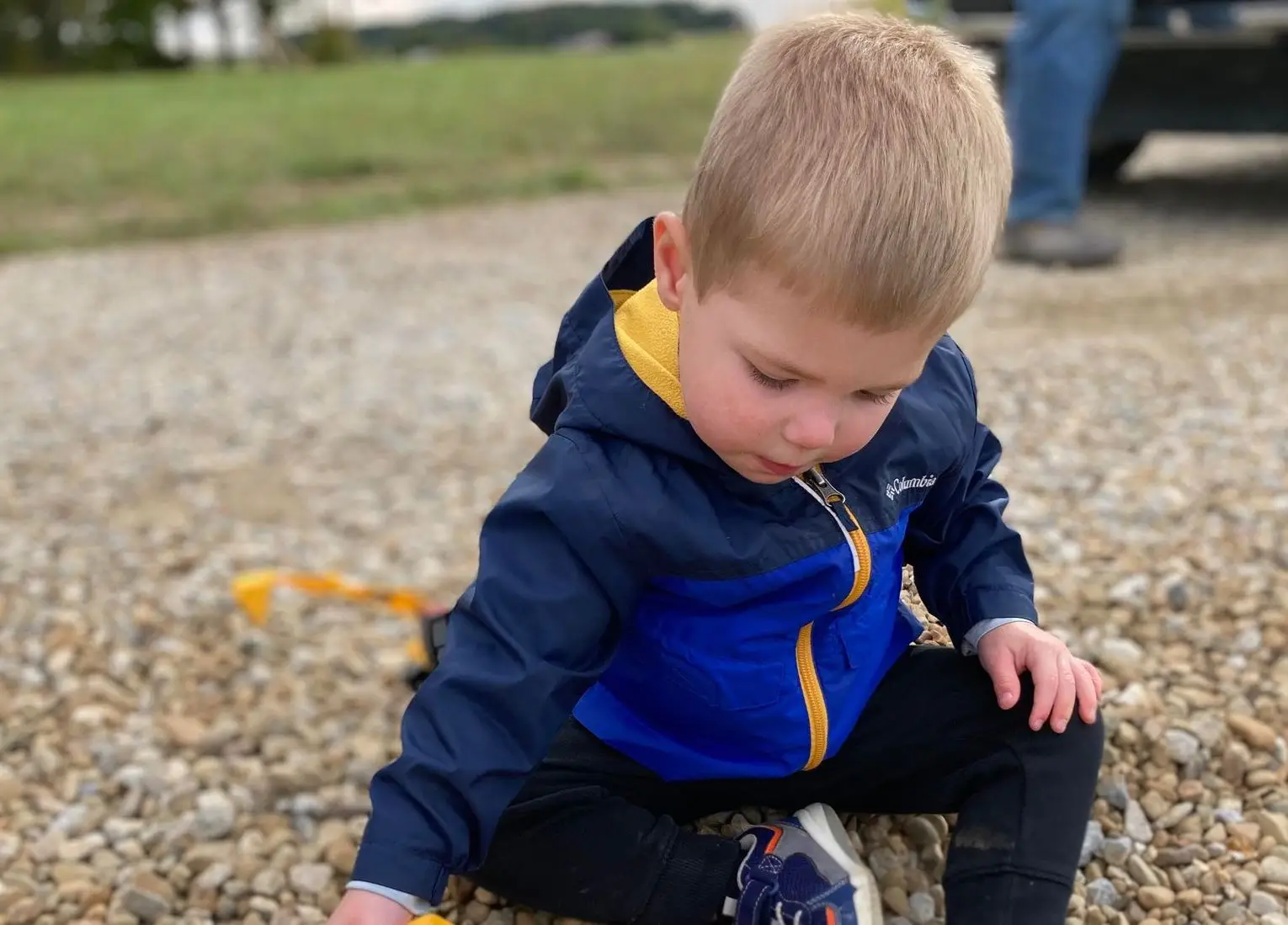Jesse’s extra X chromosome
Haddie* lives in the Midwest with her family. She opted for noninvasive prenatal testing, or NIPT, when pregnant with her son Jesse. As a special education teacher, Haddie wanted to prepare for any possibilities regarding her pregnancy. She wasn’t expecting to learn her little boy Jesse had an extra X chromosome.
Klinefelter syndrome diagnosis:
 While pregnant with her first child, Haddie wanted a NIPT, which surprised her doctor. Haddie was young, and it was her first pregnancy. There were no indicators anything was wrong, so they questioned why she wanted the test. However, it felt important to her. As a special education teacher, Haddie understood the importance of early intervention. She wanted as much information as possible about the baby.
While pregnant with her first child, Haddie wanted a NIPT, which surprised her doctor. Haddie was young, and it was her first pregnancy. There were no indicators anything was wrong, so they questioned why she wanted the test. However, it felt important to her. As a special education teacher, Haddie understood the importance of early intervention. She wanted as much information as possible about the baby.
Haddie was adamant about taking the test and offered to pay for it out of pocket. Her OB/GYN reluctantly agreed. Haddie and her husband clarified that regardless of the test results, they didn’t want to know the baby’s sex.
About a week and a half later, while at work, Haddie received an unexpected call from a genetic counselor. At the time, no one at work knew she was pregnant. Since taking the test, Haddie and her husband had decided to find out the baby’s sex, so she was excited to receive the call. She quickly asked the counselor not to divulge the sex since her husband wasn’t there. Haddie requested the counselor call back and leave a voicemail for them to listen together.
There was unexpected hesitation on the other line. Haddie’s eyes filled with tears as she recalled what came next. The genetic counselor told her something flagged the NIPT results.
An unexpected phone call:
To tell Haddie the results, she’d also have to say to her the sex of the baby. They were expecting a boy who might have an extra X chromosome. Even though they told her the condition is relatively common, with one in 600 to one in 900 male babies being born, Haddie had never heard of it before. She felt “in denial” that her son could have an extra X chromosome and was “in a fog” as she tried to understand what the genetic counselor was saying.
Through the waves of emotion, she heard the counselor say she could have an extra X chromosome, which the test could’ve picked up on. Haddie remained quiet throughout the conversation, knowing her emotions would overcome her if she spoke. One thing the counselor said about the baby pierced through the cloud of fear. She said, “he is who he was before the diagnosis. He’s your boy, and he’s okay.” Those words gave Haddie the courage to keep it together for the rest of the day.
Finding more information:
On her way home from work, Haddie called her husband to break the news to him. Through her tears, she told him the results of the NIPT had returned something unexpected. That evening, the couple extensively researched their son’s potential diagnosis. The information they found was “awful.” Her husband wanted to examine their options and expressed concern about the baby’s quality of life. He felt being proactive was the best approach. The couple decided to arm themselves with as much information as possible.
The pain of that conversation was evident as Haddie recalled it. She’d already begun feeling her son kick and couldn’t imagine terminating the pregnancy. They wanted their son to live a safe, comfortable, and productive life. The more they learned, the more infertility seemed to be the major obstacle. The rest of the possible symptoms felt manageable. To them, infertility didn’t seem enough of a reason to terminate an otherwise healthy pregnancy.
Healthcare providers:
Haddie and her husband met with a maternal-fetal medicine specialist, but the appointment was jarring and disappointing. The doctor was cold and clinical. He let the couple know their options: to confirm the diagnosis with amniocentesis or terminate the pregnancy. A final vote was presented; they could proceed with the pregnancy and confirm the diagnosis when their son was born. After delivering their options, the doctor left the room without answering their questions. The interaction left Haddie and her husband shaken, trying to figure out their options without much guidance.
They continued researching and scheduling appointments with the genetic counselor who had given them the news. Haddie came prepared with a binder of information she found online and pages of questions.
Fortunately, the genetic counselor was “fantastic” and helped alleviate some lingering anxieties the couple was still experiencing. She walked them through their options and didn’t pressure them to decide. However, the information she had to offer about Klinefelter syndrome could have been more extensive. Much of it, Haddie had already found herself online. Haddie asked if there was a support group in the area or any other parents they could talk with, but there was none. Despite the negative information, Haddie knew “everything was going to be fine.”
Pregnancy:
After receiving the diagnosis and deciding to continue the pregnancy, Haddie’s maternal-fetal doctors closely monitored her. She grieved and worked on processing the diagnosis, including going to a therapist for a few visits.
The support she hoped for from her OB/GYN didn’t happen. The OB/GYN was “odd” throughout the pregnancy and dismissive of Haddie’s questions. She’d never delivered a baby with Klinefelter syndrome before. They told Haddie the baby was at risk of being more significant. They sent her for several additional scans throughout the pregnancy to monitor his weight. Jesse was born weighing seven pounds, four ounces.
Birth:
When Jesse was born, they tested him to confirm the diagnosis. In the meantime, he took well to nursing and was a healthy newborn. Weeks dragged by while the new parents anxiously waited for the test results. Haddie called the pediatrician’s office daily to request the results, but the pediatrician seemed unconcerned. She wondered if she was worrying for nothing after more than a month without any news.
She thought perhaps the NIPT results had been wrong. When the pediatrician eventually called to confirm the diagnosis, it felt like the world fell out from under her again. She was going through another grieving process as she worked through her feelings and came to terms with the diagnosis.
Living With XXY:
Haddie and her husband decided to keep Jesse’s diagnosis to themselves. They told their parents, who were supportive. It felt important to the couple to allow Jesse to determine if he wanted to share his diagnosis. They wanted him to “have his own choices, opinions, and thoughts.” They plan to be as proactive as possible regarding his care and provide all the opportunities he needs to grow up happy and healthy.
Today, Jesse is a healthy and happy two-year-old. He’s a proud big brother who is terrific with his little brother and is very social, with many friends at daycare whom he loves to hug and give high fives. His fine motor skills are excellent, and he enjoys taking things apart to find out how they work, then putting them back together.
Jesse is on track developmentally. He hasn’t needed any other early intervention services besides physical therapy. Jesse does live with epilepsy, which is not correlated to Klinefelter syndrome but is a secondary diagnosis.
What she would want other parents to know:
When asked what she’d want other parents to know about their son’s Klinefelter syndrome diagnosis, Haddie had a few thoughts to offer. She wished she could return to enjoy her pregnancy a little more and spend less time worrying about the diagnosis. She added that early intervention is crucial and wanted parents to know “everything is going to be fine.”
What she would want healthcare providers to know:
We asked Haddie what she wished her providers had done differently about sharing the news of Jesse’s diagnosis. She replied, “Everything.” She felt as though providers needed more information to offer. Fortunately, the experience with the genetic counselor helped, but she hoped for something else when working with a healthcare provider.
*Names and other identifying information have been changed to protect the participants’ privacy.




Leave A Comment